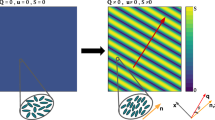Abstract:
In culture migrating and interacting amoeboid cells can form nematoid arrangements in analogy to a nematic liquid crystal phase. A nematoid arrangement is formed if the interaction has an apolar symmetry. Different cell types like human melanocytes (= pigment cells of the skin), human fibroblasts (= connective tissue cells), human osteoblasts (= bone cells), human adipocytes (= fat cells) etc., form a nematoid structure. Our hypothesis is that elastic properties of these nematoid structures can be described in analogy to that of classical nematic liquid crystals. The orientational elastic energy is derived and the orientational defects (disclination) of nematoid arrangements are investigated. The existence of half-numbered disclinations shows that the nematoid structure has an apolar symmetry. The density- and order parameter dependence of the orientational elastic constants and their absolute values are estimated. From the defect structure, one finds that the splay elastic constant is smaller than the bend elastic constant (melanocytes). The core of a disclination is either a cell free space or occupied by non oriented cells (isotropic state), by a cell with a different symmetry, or by another cell type.
Similar content being viewed by others
Author information
Authors and Affiliations
Additional information
Received 3 May 1999 and Received in final form 29 September 1999
Rights and permissions
About this article
Cite this article
Kemkemer, R., Kling, D., Kaufmann, D. et al. Elastic properties of nematoid arrangements formed by amoeboid cells. Eur. Phys. J. E 1, 215–225 (2000). https://doi.org/10.1007/s101890050024
Issue Date:
DOI: https://doi.org/10.1007/s101890050024




